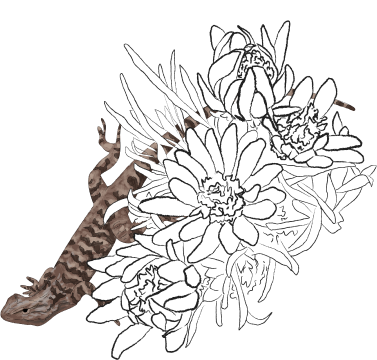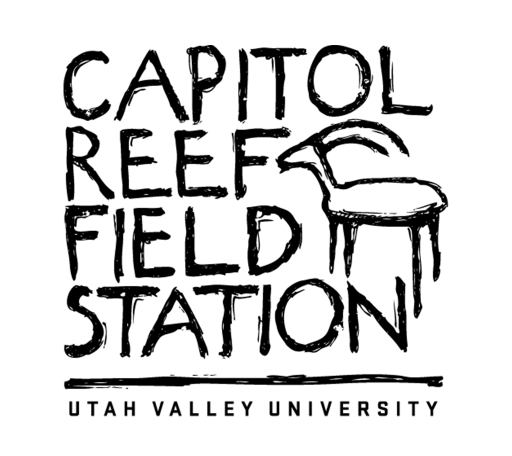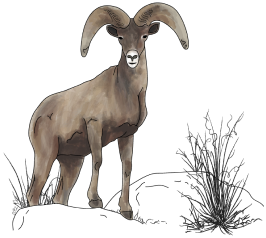Purshia tridentata (Pursh) DC.
Viridiplantae > Streptophyta > Streptophytina > Embryophyta > Tracheophyta > Euphyllophyta > Spermatophyta > Magnoliopsida > Mesangiospermae > eudicotyledons > Gunneridae > Pentapetalae > rosids > fabids > Rosales > Rosaceae > Dryadoideae > Purshia > Purshia tridentata [1]
![Purshia tridentata plant [2].](/crfs/images/native-plants/plant-directory/antelopebitterbrush-first.jpg)
Purshia tridentata plant [2].
Shrubs bearing many branches up to 2m tall; branchlets brown and tomentulose (covered with a dense layer of short, matted, wooly hairs). Leaves 4-20mm long, 2-12mm wide, cuneate (wedge-shaped) and 3-5 toothed apically, green above and grayish tomentulose below, margins more or less revolute (rolled downward to underside of leaf). Flowers with petals pale yellow to yellow or white, 5-9 mm long, oblong to obovate or spatulate in shape. Hypanthium (structure where basal portions of the calyx, the corolla, and the stamens form a cup-shaped tube) tomentose and stipitate glandular (bearing glands). Sepals mostly 4-6 mm long, ovate to oblong and entire (have a smooth, undivided outline). Fruit achenes, obliquely ovoid in shape, 1-2 cm long, the beak 1/3 the length of the achene and puberulent (with fine hairs) [3].
![Purshia tridentata flower [4].](/crfs/images/native-plants/plant-directory/antelopebitterbrush-sec.jpg)
Purshia tridentata flower [4].
In its vegetative or flowering state, P. tridentata can resemble Purshia stansburyana, the Cliffrose, and Fallugia paradoxa, the Apache Plume. However, both of these have feathery, plumose appendages that are persistent on the fruit and are longer than 1 cm in length, whereas P. tridentata lacks such an appendage, but instead has a short, hard beak less than 1 cm long [5]. When fruits are not present, P. tridentata can be distinguished from the others by having just 1 or 2 pistils (female flower parts) whereas the others have 4 or more.
Purshia tridentata is a member of the rose family (Rosaceae), named in honor of the botanist Frederick T. Pursh (1774-1820). The species is similar to and hybridizes with Glandular Bitterbrush (P. glandulosa) and Cliffrose (P. stansburyana) [10]. Both cliffrose and bitterbrush possess the basic chromosome number of n=9 and have been classified in the Rose family based on their achene fruit types. The diversity in characters among both different populations and different individuals of bitterbrush has in part been explained by the phenomenon of introgression whereby gene flow from cliffrose expands into populations of bitterbrush far beyond their contact zone [11], creating intermediate forms that make identification difficult in some populations.
![1. Fruits forming on P. tridentata [6].](/crfs/images/native-plants/plant-directory/antelopebitterbrush-identification1.jpg)
Fruits forming on P. tridentata [6].
![2. Immature fruit (note this image is a P .tridentata var. tridentata species) [7].](/crfs/images/native-plants/plant-directory/antelopebitterbrush-identification2.jpg)
Immature fruit (note this image is a P .tridentata var. tridentata species) [7].
![Apache plume (Fallugia paradoxa) fruit [8].](/crfs/images/native-plants/plant-directory/antelopebitterbrush-identification3.jpg)
Apache plume (Fallugia paradoxa) fruit [8].
![Cliffrose (Purshia stansburyana) fruit [9].](/crfs/images/native-plants/plant-directory/antelopebitterbrush-identification4.jpg)
Cliffrose (Purshia stansburyana) fruit [9].

![Closer look at the three-lobed leaves [14]](/crfs/images/native-plants/plant-directory/antelopebitterbrush-third.jpg)
Closer look at the three-lobed leaves [14].
Native American tribes across the west used antelope bitterbrush for a variety of different uses, mostly medicinal. Paiute tribes in Nevada would brew leaves and twigs to treat colds, pneumonia, and skin problems. The brewed tea was taken as a tonic and used as a wash to treat smallpox, chickenpox, and measles. The tribe would also use sun-dried leaves to treat intestinal worms [16] and Paiute tribes in Oregon were found to use the bark to make moccasins [17]. Also in Oregon, the Klamath tribes used the seed coat to make a vibrant violet dye for arrows, bows, and other objects. Infusion of the roots was used to treat lung and bronchial troubles by Klamath tribes in Oregon and California [18]. Navajo tribes utilized the bark for diapers [19], the leaves for ceremonial purposes, a root tonic to facilitate the delivery of placenta, and hunters would chew the leaves for good luck [20]. Along with being an important browse plant for deer, domestic livestock, and antelope, P. tridentata provides cover for small animals and birds [11].
![County level range map of Purshia tridentata [21].](/crfs/images/native-plants/plant-directory/antelopebitterbrush-fourth.jpg)
County level range map of Purshia tridentata [21].
Being a widespread native plant and considered an endemic species which has a broad ecological amplitude, Purshia tridentata is apparently secure. However, some populations are showing decline and lack of regeneration after fire events and overgrazing. Purshia tridentata is a fire, browse, and drought-adapted species. However, the plant's response varies depending on time of year, the intensity of the event, plant age, specific microclimate at its location, and recovery time (in years) [10].
Antelope Bitterbrush is found in sagebrush-grass, mountain brush, pinyon-juniper, and ponderosa pine communities at 1,220 - 2,775 meters throughout all Utah counties [7]. The shrub is common in the northern areas of Capitol Reef and can be found in Arches, Cedar Break, Canyonlands, Bryce Canyon, and Zion [21]. It is also common in much of western North America and thrives in semi-arid environments, is adapted to a wide range of soils,and tends to be found on dry slopes in higher elevation [8]. Can often be found as an understory plant in association with taller growing trees [19]. Flowering occurs April - June. This particular species has some ability to fix nitrogen and is the host plant for Behr’s Hairstreak butterfly (Satyrium behrii). The shrub does not tolerate shade and is mostly killed by fire [7].
[1] Schoch CL, et al. NCBI Taxonomy: a comprehensive update on curation, resources and tools. Database (Oxford). 2020: baaa062. PubMed: 32761142 PMC: PMC7408187.
[2] Lavin, M. (2016a). Purshia tridentata at Island Park Reservoir. photograph, Island Park, Fremont, Idaho. https://www.flickr.com/photos/plant_diversity/27572642071
[3] Welsh, S. L., Atwood, N. D., Goodrich, S., & Higgins, L. C. (2018). A Utah flora (5th, revised 2015 ed.). Marcus E. Jones Endowment Fund Monte L. Bean Life Science Museum Stanley L. Welsh Herbarium Brigham Young University.
[4] Davis, N. (2013). Purshia tridentata flower . photograph, Draper, Utah https://www.wildutah.us/html/plants_scenery/h_purshia_tridentata_antelope_bitterbrush_buckbrush.html
[5] Springer, (2011). Purshia tridentata . SEINet Portal Network https://swbiodiversity.org/seinet/taxa/index.php?taxon=Purshia+tridentata&formsubmit=Search+Terms
[6] Botany, A. (2017). Fruits forming on antelope bitterbrush (Purshia tridentata). photograph, Idaho Botanical Garden. https://awkwardbotany.com/2017/03/29/seed-dispersal-via-caching-the-story-of-antelope-bitterbrush/
[7] Tuason, T. (2011). Purshia tridentata immature fruit at Leavenworth Ski Hill. photograph, Chelan County Washington. https://commons.wikimedia.org/wiki/File:Purshia_tridentata_var._tridentata_9.jpg
[8] Mayfield , T. (2021). Apache plume (Fallugia paradoxa). Photograph. https://commons.wikimedia.org/wiki/File:Fallugia_paradoxa_163852449.jpg
[9] Shebs , S. (2006). Purshia stansburiana in Lovell Canyon, Spring Mountains, southern Nevada. photograph. https://commons.wikimedia.org/wiki/File:Purshia_stansburiana_10.jpg
[10] Purshia tridentata Antelope Bitterbrush. NatureServe Explorer 2.0. (2023, December 1). https://explorer.natureserve.org/Taxon/ELEMENT_GLOBAL.2.146660/Purshia_tridentata
[11] Alderfer, J. (1976). A taxonomic study of bitterbrush (Purshia tridentata (Pursh) DC.) in Oregon. : Oregon State University.
[12] Dyer, D.; O’Beck, R.; Noller, G.L. Plant Guide: Antelope Bitterbrush Purshia Tridentate (Pursh) DC 2018. https://plants.usda.gov/plantguide/pdf/pg_putr2.pdf
[13] Gauna , F. J. (n.d.-b). Bitterbrush (Purshia tridentata (Pursh) DC.) . USDA US Forest Service . https://www.fs.usda.gov/wildflowers/plant-of-the-week/purshia_tridentata.shtml
[14] Harte, M. E. (Mel). (n.d.). antelope bitterbrush (Purshia tridentata). photograph. https://www.invasive.org/browse/detail.cfm?imgnum=2126032
[15] Train, Percy, James R. Henrichs and W. Andrew Archer, 1941, Medicinal Uses of Plants by Indian Tribes of Nevada, Washington DC. U.S. Department of Agriculture, page 126-128
[16] Fowler, C.S., (1989), Willards Z. Park's Ethnographic Notes on the Northern Paiute of Western Nevada 1933-1940, Salt Lake City. University of Utah Press, page 126
[17] Mahar, J.M, (1953), Ethnobotany of the Oregon Paiutes of the Warm Springs Indian Reservation, Reed College, B.A. Thesis, page 82
[18] Coville, F.V., (1897), Notes On The Plants Used By The Klamath Indians Of Oregon., Contributions from the U.S. National Herbarium 5(2):87-110, page 98
[19] Hocking, George M., 1956, Some Plant Materials Used Medicinally and Otherwise by the Navaho Indians in the Chaco Canyon, New Mexico, El Palacio 56:146-165, page 154
[20] Vestal, P. A., (1952), The Ethnobotany of the Ramah Navaho, Papers of the Peabody Museum of American Archaeology and Ethnology 40(4):1-94, page 31
[21] Purshia tridentata (Pursh) DC. USDA plants database. (n.d.). https://plants.usda.gov/home/plantProfile?symbol=ARTR2
[22] Clark, D. J. (2021). Wildflowers of Utah’s Colorado Plateau: A field guide to wildflowers of Captiol Reef National Park and surrounding areas of Southern Utah. Trails Books, an imprint of Bower House.



